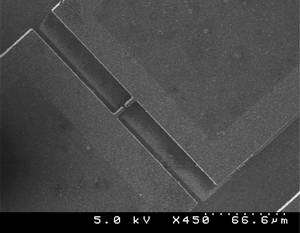Researchers grow carbon nanotubes in lab using faster, cheaper means

Basic building blocks of nanotech, carbon nanotubes will help carry the $850 billion electronics industry forward
A Case Western Reserve University engineer has created the "seeds" that can grow into today's and tomorrow's computer and phone chips.
In a development that could lead to smaller but more powerful computers and electronic communication devices, Massood Tabib-Azar, a professor of electrical engineering and computer science at Case, and engineering graduate student Yan Xie are growing carbon nanotube bridges in their lab that automatically attach themselves to other components without the help of an applied electrical current.
Carbon nanotubes, discovered just 14 years ago, are stronger than steel and as flexible as plastic, conduct energy better than almost any material ever discovered and can be made from ordinary raw materials such as methane gas. In a relatively short time, carbon nanotubes – thin tubes of carbon atoms that have unusual characteristics because of their unique structure – have emerged as a "miracle material" that could revolutionize a number of industries, especially the small electronics industry.
What makes this discovery significant, Tabib-Azar says, is that, while there are some technical issues yet to be addressed, carbon nanotube bridges may open the door for manufacturers to utilize carbon nanotubes in building the tiniest computer and communication chips. Carbon nanotubes are being explored for many applications in nanoelectronics, nano-electromechanical systems, biosensors, nano-composites, advanced functional materials and meta-materials.
New and cheaper ways to grow carbon nanotubes can improve companies' competitive edge, says Tabib-Azar. The researchers' method is much less expensive and quicker to perform and results in a self-assembled network of carbon nanotube devices.
Tabib-Azar likens making today's computer and cell phone chips to building a table by chopping down a tree and eliminating the unwanted portions until you end up with a flat surface with four legs. He and Xie discovered that you can grow building blocks of ultra large scale integrated circuits by growing self-assembled and self-welded carbon nanotubes much the same way you'd build that table. However, instead of chopping down the whole tree, all you have to do is create the "seeds" to grow what you need. In other words, Tabib-Azar and Xie have found the seeds to grow just the carbon nanotubes that are needed without wasting the entire "tree."
"Our approach is like growing a table using a 'table seed,' said Tabib-Azar. "By growing the electronic circuits rather than chopping down and eliminating unwanted regions of different layers, our approach has the potential of producing very complex chips with superior computational properties and at the same time being less wasteful and more in tune with the way nature 'builds' complex structures."
"Electronics is at the heart of global competition among superpowers," he continued. "And it's important to note that the electronics world market is an $850 billion industry."
Tabib-Azar predicts that within five to 10 years the United States' ability to double the number of switches per chip every 18 months will be diminished if American electronics companies don't remain competitive.
In order to use carbon nanotubes in electronics where they may greatly benefit device performance and enable cramming in more devices per chip, the nanotubes should be connected to electrical contacts. Until now, the researchers say, to connect carbon nanotubes to electrical contacts, very high precision tools such as atomic force microscopes were used that made the resulting devices very expensive. Or, in the past, researchers have used electric forces to grow carbon nanotubes between two contacts. Both these techniques result in a very few devices and can't be used for producing a large number of switches and devices in a cost-effective way.
"There are many research efforts in the U.S. and across the world to invent and discover the transistors and switches that will be more suitable to chips used in cell phones and computers beyond 2010-2015," said Tabib-Azar. "Carbon nanotubes have emerged as one of the candidates to carry the electronics industry forward."
Source: Case Western Reserve University


















